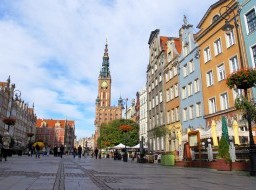Oliwa Cathedral
The Oliwa cathedral as we know it today was built from the 13th to till the 18th century. With a length of 107 meters it is the longest church in Poland. Oliwa's towering Cathedral taking pride of place at the western end of Oliwa Park was originally built as a simple wooden structure in the 12th century, and it was only in 1224 that the brickwork was added. The year 1350 saw a half-wit kitchen boy accidentally start a fire that engulfed the whole building. Reconstruction began immediately, but in 1626 the building was again destroyed, this time by marauding Swedish soldiers. Not content with stealing its bells, altars and valuables, the Swedes kidnapped Oliwa’s hapless monks for good measure and in a twist of irony, it was in this very building that Poland and Sweden finally put the past behind them and signed a peace treaty in 1660. Built along a classic three-aisle design with a vaulted basilica and shaped in the form of the Latin cross, today's interior is dominated by the extraordinary organ over the main entrance. Built between 1755 and 1780 by the organ master Johann Wulf, and at the time the largest organ of its type in Europe, it features moving cherubs, trumpet-playing angels and comes with a staggering 7,896 pipes and 110 registers allowing for an incredible range of pitch and sounds including rippling water, animal cries and human voices; hear it for yourself at the hours listed. A couple of other points of note are the memorial plague to inter-war Danzig bishop Edward O’Rourke found on the wall to the right as you enter from the main entrance and, at the other end of the church, a strange and beautiful canopy around the high altar, covered with stars and featuring 150 angels poking out of a mass of clouds. There are two organs located in the cathedral: A small choir organ from 2003 with a 16th century case, and the big main organ built 1763 - 1788. The instrument was rebuilt on several occasions, most recently in 1966 - 1968 . The organ case is unique in the world and is considered one of the largest cases world wide. |




